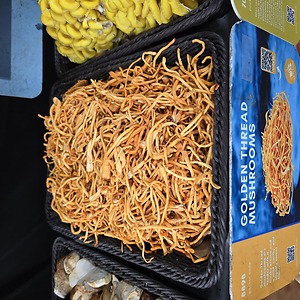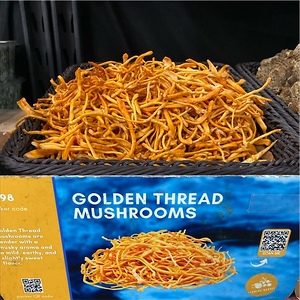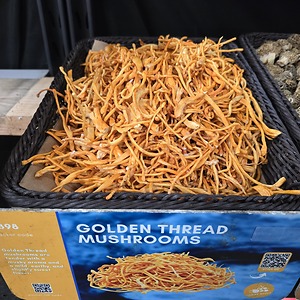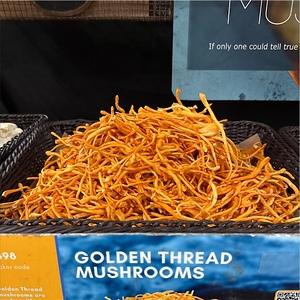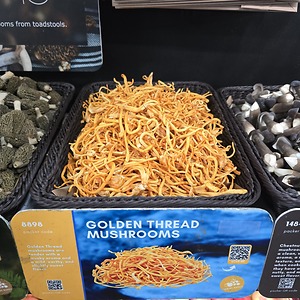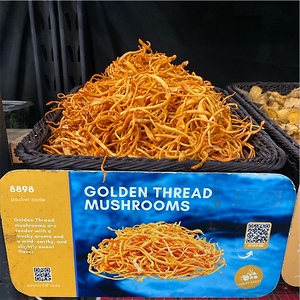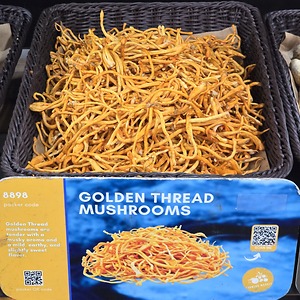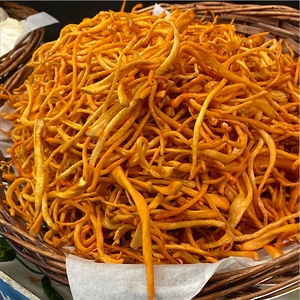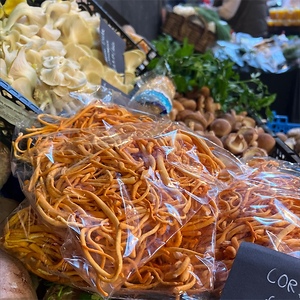


Golden Thread Mushrooms
Estimated Inventory, lb : 10.70
This item was last sold on : 07/19/25
Description/Taste
Golden Thread mushrooms vary in size and appearance, depending on the species and growing environment. The mushrooms are generally small, averaging 2 to 8 centimeters long, and have a slender, thin, elongated, spindly shape. Golden Thread mushrooms have slight curves to their shape and showcase a golden yellow-orange hue. Each mushroom has a light texture, and at the tips of the mushrooms are tiny, round, or club-like ends. Golden Thread mushrooms are pliable, slightly spongy, and soft when raw, becoming tender and pleasantly chewy once cooked. If the mushroom is sliced in half, it will reveal a pale orange to white interior. Golden Thread mushrooms are edible raw or cooked, emitting a faintly nutty, musky aroma. The mushrooms have a mild, earthy, subtly sweet, and savory flavor.
Seasons/Availability
Wild Golden Thread mushrooms are available in limited quantities in the summer. Cultivated Golden Thread mushrooms are available year-round.
Current Facts
Golden Thread mushrooms, botanically a part of the Cordyceps genus, are a broad category of fungus species belonging to the Cordycipitaceae family. Over 700 species are generally classified under the Cordyceps name, and these species are naturally growing in various climates worldwide. In commercial markets, Golden Thread mushrooms are primarily called Cordyceps. The most well-known species under the Cordyceps name is Cordyceps militaris. This heterotrophic species grows wild in temperate regions of Asia and is one of the few Cordyceps species that can be commercially cultivated on sterile mediums and grain substrates. It is important to note that most Cordyceps mushrooms sold for culinary purposes are cultivated mushrooms. The name Cordyceps is derived from the Greek word “kordyle,” meaning “club,” and the Latin term “ceps,” meaning “head.” This “club head” nature is a visual descriptor of how Cordyceps mushrooms grow. In the wild, Cordyceps militaris and several other species have the unique parasitic habit of feeding and growing from insects. Wild Cordyceps mushroom spores infiltrate an insect's body, mostly ants, caterpillars, spiders, and beetles, and grow inside the insect’s body, feeding off tissues and organs. Eventually, the fungus produces root-like filaments known as mycelium in the body and completely takes over the insect. The insect perishes, and a fruiting body emerges from the insect, making the slender, famous mushroom. Not all Cordyceps species develop in this parasitic method, but select species of Cordyceps are revered for their alleged medicinal properties. Wild Cordyceps are challenging to find in culinary markets and are primarily reserved as a premium medicinal aid. Cultivated Golden Thread mushrooms are a culinary ingredient chefs favor for their distinct coloring, mild flavor, and unusual appearance. The mushrooms can be used in a wide array of savory preparations and are versatile, as they can be incorporated raw or cooked.
Nutritional Value
Golden Thread mushrooms are primarily referred to as Cordyceps in medicinal evaluations. Cordyceps species have been studied for their anti-inflammatory, antioxidant, and antifungal properties and are considered a valued medicinal ingredient. Each species varies in nutritional content, but the mushrooms are known for their use in Traditional Chinese Medicine to improve energy, endurance, and boost the immune system. It is also believed that Cordyceps can help with anti-aging and respiratory diseases. The mushrooms are made into tea, tinctures, powders, and tonics. Some studies indicate select species may contain vitamins A, B, and E to maintain healthy organs and guard the cells against free radical damage. Minerals may include magnesium to control nerve functions, potassium to balance fluid levels within the body, calcium to support bones and teeth, iron, and zinc.
Applications
Golden Thread mushrooms have a mild, nutty, and earthy flavor suited for fresh and cooked preparations. The most popular method of preparing the mushrooms is to cook them, as it helps create a tender, chewy texture, but some consumers choose to add Golden Thread mushrooms raw to salads. The mushrooms can be used whole if they are smaller in size or sliced into pieces if larger and more fleshy for even consistency. Golden Thread mushrooms are famously added to soups, stews, and curries throughout Asia for enhanced coloring and texture. The mushrooms can be used as a topping over ramen, stirred into egg drop soup, or even added to chicken noodle soup as a unique variation. Golden Thread mushrooms are also simmered into broths to add savory, umami elements. In addition to soups, Golden Thread mushrooms can be sautéed in butter, salt, and pepper or braised. Once cooked, the mushrooms are served as a simple side, combined with roasted meats, tossed into noodle and rice dishes, or layered into sandwiches. Try stir-frying Golden Thread mushrooms with fresh vegetables and tofu as a main dish, or add to poultry, beef, or pork-centered recipes. The mushrooms are also mixed into pasta dishes or used as a flatbread topping. Golden Thread mushrooms pair well with vegetables like bell peppers, bok choy, watercress, and bamboo shoots, aromatics including garlic, onions, and ginger, and flavorings like sesame, white wine, and soy sauce. Unwashed Golden Thread mushrooms will last one week when stored loosely in a paper bag in the refrigerator. The mushrooms can also be dried, dehydrated, frozen, or pickled for extended use.
Ethnic/Cultural Info
In Asia, one specific Cordyceps species is highly sought after for its rarity and medicinal value. Ophiocordyceps sinensis, once classified as Cordyceps sinensis, is a species native to mountainous regions of the Himalayas. The species is locally known as Yartsa Gunbu in Tibet and Dōnɡ Chónɡ Xià Cǎo in China, both roughly translating to a version of “winter worm, summer grass.” In English, the species is called Caterpillar Fungus and grows on the caterpillars of the Ghost moth, also referred to as the Hepialus moth. It is said that the fungus infects the caterpillars in the fall, and during the winter, the mycelium develops within the insect to produce the fruiting bodies in the spring. The fruiting bodies are foraged from the wild in May and June and are often considered more valuable than gold among local villagers in Nepal and Tibet. Collecting Yartsa Gunbu is a labor-intensive process involving foragers closely inspecting and crawling along the ground to find the delicate fruiting bodies. Conflicts with other foragers and businessmen have also made the gathering dangerous, as individuals and groups have been murdered over land disputes. The demand for Yartsa Gunbu drastically increased between 1998 and 2008, leading the Chinese government to create harvesting permits for gathering the mushrooms in Tibet. Yartsa Gunbu is one of the most expensive wild mushrooms and can sell for over $20,000 per kilogram. In China, there is a saying that “those who buy it don’t eat it, and those who eat it don’t buy it.” This saying alludes to the use of Yarsta Gunbu as a gift. It is often given to people in positions of power and is a social status symbol.
Geography/History
The name Cordyceps is a general descriptor for many species native to regions around the world. These species have been growing wild since ancient times, and each has an individual history and preference for growing environments, from temperate forests, mountainous regions, grasslands, to tropical jungles. Some species of Cordyceps are more widespread than others, and the two most well-known species include Cordyceps sinensis, native to select parts of India, Nepal, Bhutan, and China, and Cordyceps militaris, native to temperate regions of Asia. Other Cordyceps species are found in the Americas, Australia, and Europe. Select Cordyceps species have been utilized in Traditional Chinese Medicine and other natural medicines for thousands of years, and for several decades, the species were only foraged. One of the first-known written medicinal documents mentioning Cordyceps was recorded in 1450 CE in Tibet. Mentions of the species also appeared in Traditional Chinese Medicine texts around 1694 CE. Cultivation of Cordyceps militaris and other species began in the late 20th century and rapidly expanded in production, especially throughout Asia, in the early 21st century. Cultivation also spread to the United States in the 21st century, and Cordyceps became an in-demand mushroom worldwide, increasing prices and availability. Today, Cordyceps species, primarily Cordyceps militaris, are commercially cultivated worldwide and are sold as a medicinal ingredient. The mushrooms are also sold for small-scale culinary use and are found through specialty stores, directly from foragers or cultivators, or seasonally through fresh markets.
Featured Restaurants
Restaurants currently purchasing this product as an ingredient for their menu.
| Mille Fleurs | Rancho Santa Fe CA | 858-756-3085 |
| Westin Gaslamp Quarter | San Diego CA | 619-239-2200 |
| Communion | San Diego CA | 619-606-5568 |
| Bridges at Rancho Santa Fe | Rancho Santa Fe CA | 858-759-6063 |
| Merenda | Oceanside CA | 703-459-4145 |
| Cal A Vie | Vista CA | 760-945-2055 |
| Institutes of Health LLC | San Diego CA | 800-270-5016 |
| Orens Fine Foods | San Diego CA | 510-910-2298 |
| Animae | San Diego CA | 619-925-7908 |
| Royal Polaris Sportfishing | San Diego CA | 619-226-8030 |
| Valley View Casino & Hotel (Black&Blue) | Valley Center CA | 760-291-5500 |
| Ju-Ichi | San Diego CA | 619-800-2203 |
| Four Seasons Residence Club | Carlsbad CA | 760-603-6360 |
| Le Coq | La Jolla CA | 858-427-1500 |
| PFC Fitness Camp | Carlsbad CA | 888-488-8936 |
| Marriott Marina Kitchen | San Diego CA | 619-234-1500 |
| The Plot | Oceanside CA | 422-266-8200 |
| Georges at the Cove | San Diego CA | 858-454-4244 |
| The Lion Share | San Diego CA | 619-564-6924 |
| Parq Restaurant and Nightclub | San Diego CA | 619-727-6789 |
| Ron Oliver | San Diego | 619-295-3172 |
| Andrew Spurgin | San Diego CA | 619-277-6020 |
| Fairmont Grand Del Mar | San Diego CA | 858-314-1975 |
Recipe Ideas
Recipes that include Golden Thread Mushrooms. One
Podcast



